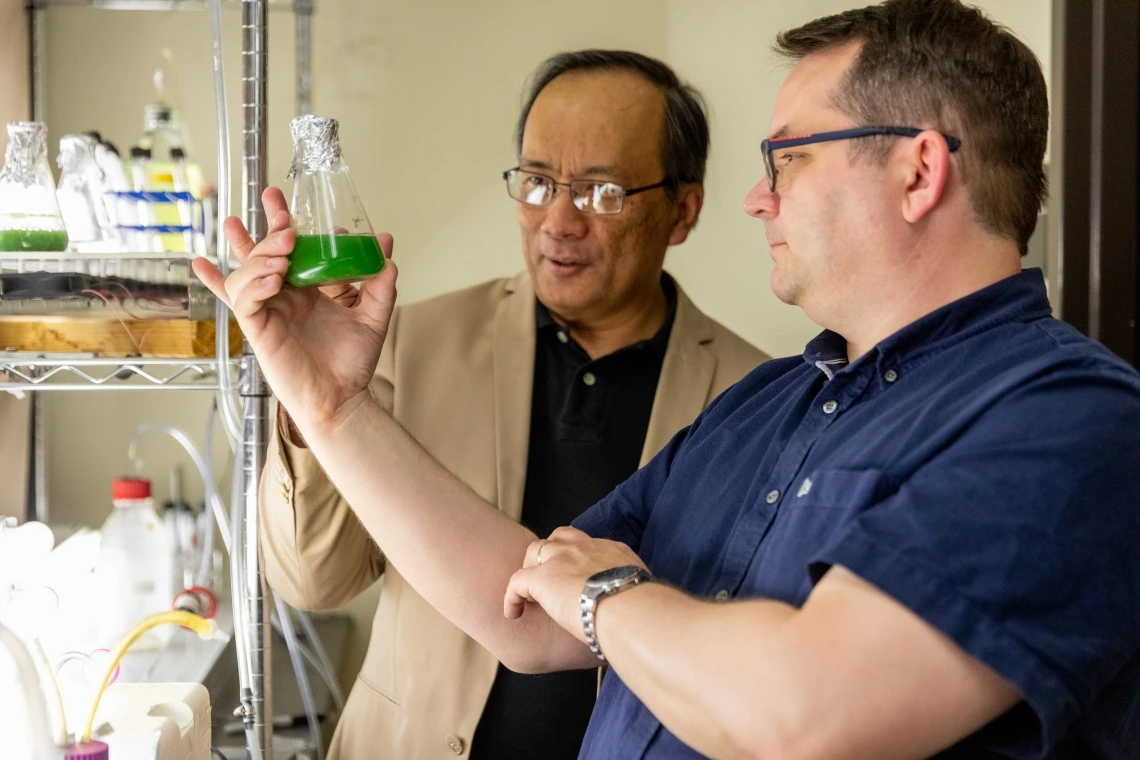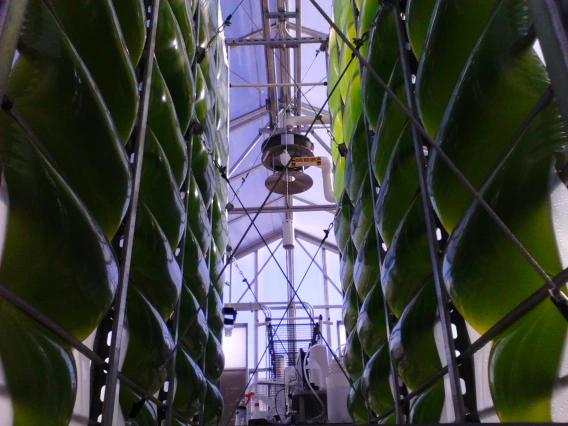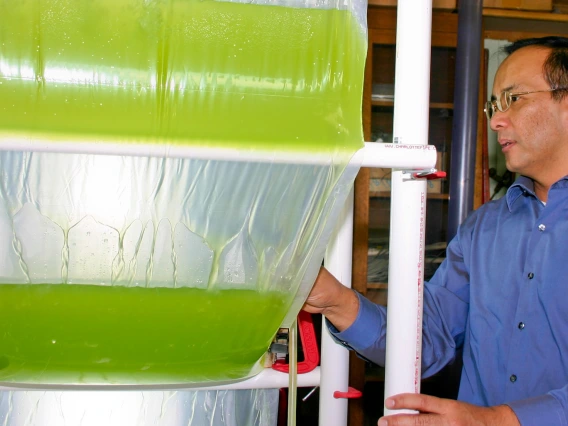Small but Mighty: How UArizona Researchers are Harnessing the Power of Algae to Capture Carbon
An astrobiologist, an engineer and an ecologist have teamed up to mitigate the worst effects of climate change.

Astrobiologist Daniel Apai (right) and biosystems engineer Joel Cuello (left) work with algae in the lab. Their team aims to harness the power of coccolithophores, which are a single-celled marine algae that use atmospheric carbon dioxide and calcium from saltwater to create intricate shells made of calcium carbonate. The shells are made from a very stable, chalk-like mineral. They can be grown efficiently, then stored to trap carbon dioxide. (Photo: Chris Richards)
As a University of Arizona professor of astronomy and planetary sciences who studies planets orbiting other stars, Daniel Apai spends much of his time thinking about what makes worlds habitable.
On Earth, the carbon cycle plays a key role in maintaining conditions for life. Earth releases carbon into the atmosphere and reabsorbs it through geological and biological processes. But humans have released more carbon dioxide into the atmosphere than the carbon cycle naturally would, causing global temperatures to rise.
Apai has assembled a team that plans to harness the principles of the carbon cycle to trap massive amounts of carbon dioxide and curb the worst impacts of climate change.
They call themselves Atmospherica. In addition to Apai, the team includes Joel Cuello, a professor of agricultural and biosystems engineering and BIO5 Institute member; Régis Ferrière, an associate professor of ecology and evolutionary biology; Martin Schlecker, an astrophysicist and postdoctoral research associate; and Jack Welchert, a biosystems engineering doctoral student.
Reports from the Intergovernmental Panel on Climate Change and future climate projections find that preventing the worst effects of climate change will require carbon removal from the atmosphere at gigaton-per-year levels.
"Yet, no existing technology is thought to be scalable enough to succeed in this," Apai said. "What we need to do as a civilization is to reduce our emissions as much as possible, because extracting from the air is much more difficult than not emitting it. No one has come up with a solution that extracts carbon dioxide so efficiently as to allow the continued burning of fossil fuels."
The Atmospherica team team hopes to be a part of the solution, by harnessing the power of algae.
It's all in the algae
"Climate change is one of the great challenges we are facing as a species and civilization," Apai said.
He began the search for potential climate change solutions as a hobby seven years ago. He found that most existing carbon removal solutions could not be scaled up to the levels required, were prohibitively expensive or were harmful to the environment.
As an astrobiologist, he decided to pursue solutions inspired by nature. That's when he learned about coccolithophores – single-celled marine algae. What makes these algae special is the fact that they use atmospheric carbon dioxide and calcium from saltwater to create intricate shells made of calcium carbonate – a very stable, chalk-like mineral. These shells evolved to protect the algae and regulate the algae's buoyancy and light exposure.
Enter the air accordion
Cuello and his Biosystems Engineering Lab have developed a portfolio of patented low-cost novel photobioreactors in which to grow algae and other types of cell cultures in an efficient and productive way. One of the designs is the air accordion photobioreactor.
The air accordion photobioreactor consists of a rectangular metal frame with horizontal bars – like steps on a ladder – spaced closer together at the bottom and farther apart at the top. A polyethylene bag full of nutrient-rich saltwater is woven throughout this ladder-like frame. Air is pumped in from the bottom and circulated through the saltwater mixture. The design maximizes the liquid-mixing capacity of air bubbles pumped in from the bottom and allows for even distribution of light and dissolved nutrients.
The photobioreactor make it possible to efficiently grow large amounts of algae. And because the algae are grown in a controlled environment, within the polyethylene bag, they are protected from predators. The researchers say their air accordion photobioreactor is also easy to scale up.
Cuello and Apai patented the use of coccolithophore algae for carbon dioxide removal in this kind of photobioreactor, and they hope to continue to optimize the design for even more efficient coccolithophore growth and carbon uptake.
"Our goal is to reach a gigaton-per-year level of carbon dioxide extraction capacity, while remaining affordable and with very limited environmental impact," Apai said.



